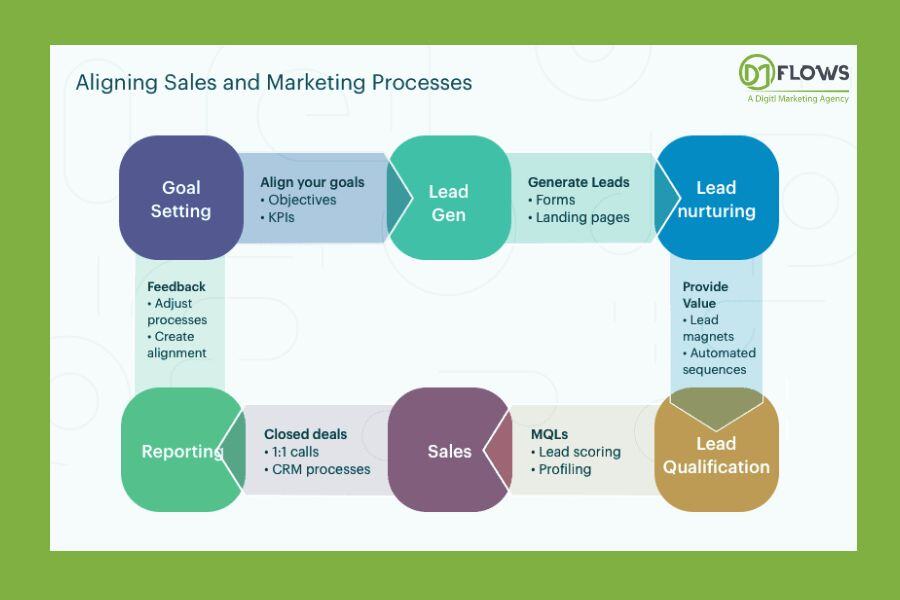Two Sides of the Coin: Sales vs Marketing Alignment
In today’s competitive business landscape, achieving sales and marketing alignment is no longer a choice, but a necessity. When these two crucial departments work together as a cohesive unit, they can drive significant growth and profitability for the organization.
This article explores the importance of sales and marketing alignment, outlines key strategies to achieve it, and provides best practices to ensure long-term success.

Sales and marketing, two sides of the same coin, forever intertwined yet distinct in their approaches. Marketing sows the seeds of interest, cultivating a fertile ground for potential customers. Sales then steps in, a skilled harvester carefully reaping the benefits of that groundwork. One is about sparking a desire, the other about guiding that desire towards a specific product or service.
They may share the ultimate goal of driving revenue, but the paths they take diverge, creating a fascinating dance of strategy and execution.
Also Read: Top CRMs for Sales and Marketing.
What Is Smarketing?
Smarketing, a term born from the marriage of “sales” and “marketing,” transcends the realm of catchy buzzwords. It embodies a fundamental shift in how businesses approach customer acquisition. Traditionally, sales and marketing operated in silos, each with their own goals and methodologies.
Marketing aimed to generate leads, a broad net cast to capture potential customers. Sales then took over, sifting through those leads and attempting to convert them into paying customers.
Why Sales and Marketing Alignment Matters

Imagine a scenario where your marketing team is generating a plethora of leads, but the sales team is struggling to convert them into paying customers. This disconnect between sales and marketing efforts can be detrimental to your bottom line.
Conversely, when sales and marketing are aligned, they can create a seamless customer journey that fosters trust, loyalty, and ultimately, sales.
Here are some of the compelling reasons why sales and marketing alignment is critical for business success:
Improved Lead Quality
Through better communication and collaboration, sales and marketing can develop a clear understanding of the ideal customer profile. This enables marketing to target the right audience with the right messaging, resulting in higher-quality leads for the sales team to pursue.
Enhanced Customer Experience
When sales and marketing are aligned, they present a unified brand message to the customer throughout the buyer’s journey. This consistency fosters trust and creates a positive customer experience, which is essential for lead conversion and customer retention.
Increased Revenue
By working together, sales and marketing can develop targeted campaigns that resonate with the target audience. This not only improves lead quality but also shortens the sales cycle, ultimately leading to increased revenue and profitability.
Streamlined Operations
Sales and marketing alignment eliminates internal friction and redundancies. By working collaboratively, both teams can leverage each other’s strengths and expertise, leading to more efficient operations and improved resource allocation.
How Sales and Marketing Harmony Can Solve Common Problems

Sales and marketing, the dynamic duo of any successful business, can sometimes find themselves working at odds. When these two departments lack alignment, it creates a maze of problems that can hinder growth and leave customers feeling confused. Fortunately, fostering collaboration between sales and marketing can be the key to untangling this maze and achieving success.
Tackling Unqualified Leads
One of the biggest issues tackled by sales and marketing alignment is the generation of unqualified leads. Marketing, aiming for a wide net, might attract a large pool of potential customers, but not all of them will be a good fit for the product or service. Sales, frustrated by spending time on leads that don’t convert, can become demoralized.
Alignment bridges this gap by establishing clear buyer personas. Marketing, armed with this knowledge, tailors its outreach to attract the right kind of customer, while sales gets a more targeted pool of qualified leads to nurture, leading to higher conversion rates and happier salespeople.
True Value Proposition
Another hurdle overcome by a unified sales and marketing front is mixed messaging. Inconsistent brand messaging across different channels creates confusion for potential customers. Imagine encountering a playful and informal marketing campaign followed by a dry and technical sales pitch. This disconnect can damage brand trust and make it difficult for customers to understand the true value proposition.
Alignment ensures that both teams are singing from the same hymn sheet, delivering a consistent message that resonates throughout the customer journey.
Close Deals More Effectively
Furthermore, a lack of communication between sales and marketing can lead to missed opportunities and wasted resources. Sales might be unaware of new marketing initiatives that could enhance their pitches, while marketing remains in the dark about the specific challenges and objections faced by the sales team.
Alignment fosters open communication, allowing both teams to share insights and strategies. This information exchange empowers marketing to create content that directly addresses customer pain points, while sales can leverage this content to close deals more effectively.
Shared Metrics to Track the Customer Journey
Finally, misaligned sales and marketing metrics can create a culture of finger-pointing and blame. Marketing might focus on lead generation numbers, while sales prioritizes closing deals. This disconnect prevents both departments from working towards a common goal.
Alignment establishes shared metrics that track the entire customer journey, from initial brand awareness to conversion and beyond. This holistic view allows both teams to celebrate successes together and identify areas for improvement as a united front.
Sales and Marketing Alignment Strategies

Sales and marketing, often seen as separate entities, are truly two halves of a well-oiled revenue machine. When misaligned, they can create friction, with marketing generating leads that sales struggle to convert, and sales complaining about the quality of those leads.
However, by implementing strategic alignment tactics, these teams can transform into a formidable force, generating a smoother customer journey and boosting the bottom line.
Building a Shared Vision
The foundation of alignment lies in a common understanding of the ideal customer profile (ICP). Both teams must have a clear picture of who they’re targeting, their pain points, and aspirations. This shared vision allows marketing to craft targeted messaging that resonates with the ICP, while sales can tailor their pitches to address specific needs.
Metrics that Matter
Gone are the days of siloed goals. Sales and marketing should establish key performance indicators (KPIs) that are mutually beneficial. This could involve metrics like lead generation rate, lead conversion rate, and customer lifetime value. By focusing on these shared objectives, both teams are incentivized to work together towards the same outcome.
The Power of Communication
Open and consistent communication is the lifeblood of alignment. Regular meetings, not just for reporting, but for brainstorming and strategy sessions, are crucial. Sales can provide valuable feedback on marketing materials and messaging, while marketing can gain insights into customer needs and objections faced by the sales team. This two-way flow of information ensures all efforts are targeted and effective.
Content Collaboration
Marketing doesn’t exist in a vacuum. Sales reps are on the front lines, gathering valuable customer insights that can be used to create content that resonates. Collaboration on content creation allows marketing to leverage sales expertise, resulting in materials that directly address customer concerns and objections. This joint effort can lead to more qualified leads and a smoother sales cycle.
Seamless Lead Handoff
The transition from marketing-generated lead to sales prospect can be a delicate dance. Establishing clear lead scoring and qualification criteria ensures only the most promising leads reach sales. Additionally, a well-defined handoff process, complete with clear communication of lead information and customer engagement history, allows sales reps to hit the ground running and efficiently close deals.
Service Level Agreements (SLAs)
Develop SLAs that outline the expectations for each department. For instance, marketing can agree to deliver a certain number of qualified leads per month, while sales can commit to following up on leads within a specific timeframe.
Celebrating Success (and Learning from Failure)
Recognition goes a long way. When sales and marketing achieve shared goals, celebrate the victories together. This reinforces the importance of teamwork and motivates both teams to maintain alignment. However, it’s equally important to analyze failures together. By dissecting what went wrong, both teams can learn and adapt their strategies, continuously improving their effectiveness.
By implementing these tactics, sales and marketing can bridge the gap between them, transforming from separate entities into a collaborative force that drives revenue growth and fosters a positive customer experience. The result? A well-oiled machine that consistently delivers results.
However, A CRM also plays an important role in this and among many options, HubSpot is one of the best CRM that can help you align sales and marketing teams.






